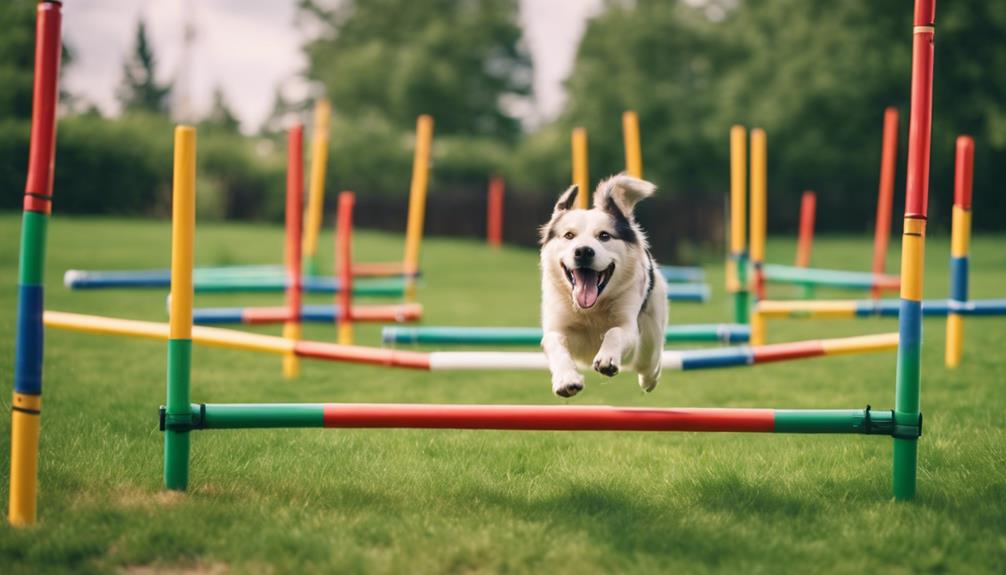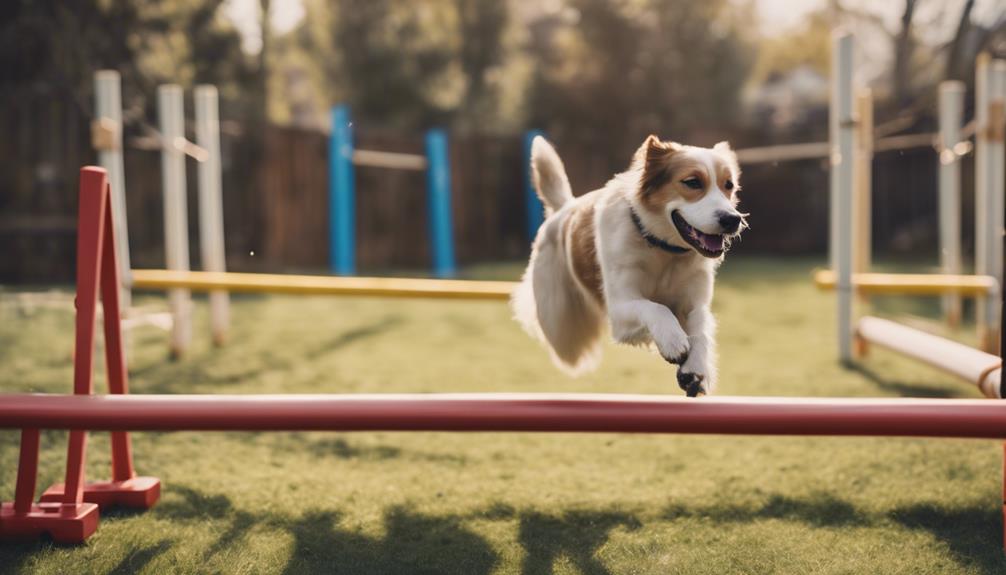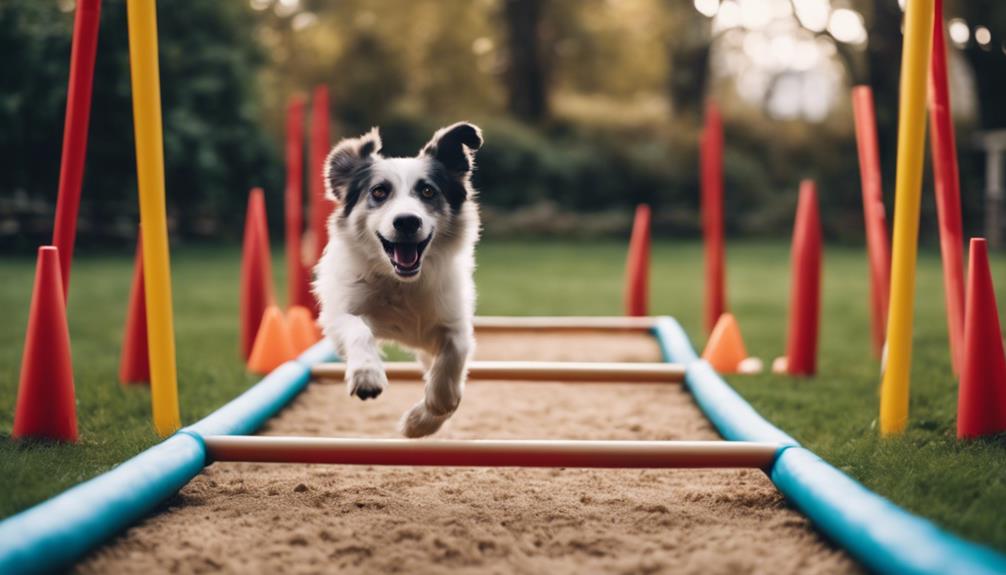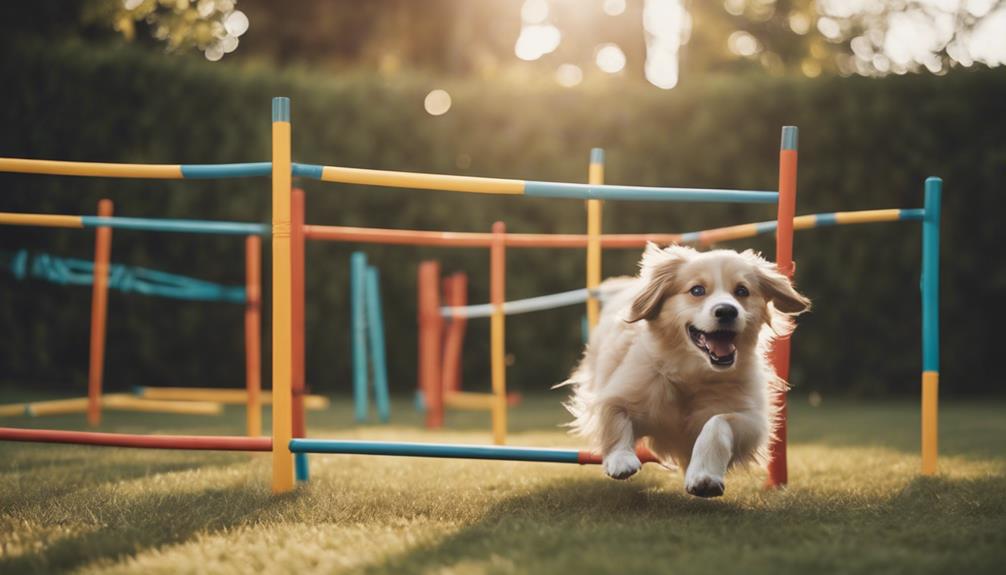Constructing a DIY dog agility course in your backyard can offer a myriad of benefits for both you and your four-legged companion. From enhancing physical fitness to promoting mental stimulation, agility training can be a rewarding experience. By carefully selecting equipment and incorporating homemade obstacles, you can create a challenging yet enjoyable course suitable for dogs of all skill levels.
However, the key to a successful agility course lies not just in its construction but also in the training techniques employed. Stay tuned to discover essential tips and strategies to maximize the effectiveness of your DIY dog agility course.
Key Takeaways
- DIY dog agility courses promote physical and mental exercise for dogs.
- Building agility courses at home fosters teamwork and trust with your dog.
- Utilizing household items for obstacles is a cost-effective way to engage your dog.
- Community involvement through clubs enhances your dog's agility skills and socialization.
Necessary Equipment for DIY Course
To set up a DIY dog agility course, acquiring the essential equipment is paramount to ensure a successful training experience for both you and your furry companion. Basic equipment includes items such as buckets, a broomstick, a cardboard box, a blanket, and garden stakes.
These items can be repurposed to create a variety of obstacles suitable for beginners. For instance, a jump obstacle can be fashioned using a broomstick and buckets, while a tunnel can be made from a cardboard box or blanket. Additionally, weave poles can be set up using garden stakes, which can be further enhanced by covering them with PVC pipe for durability.
Basic DIY Obstacles to Start
Commence your DIY dog agility course by setting up fundamental obstacles using household items such as buckets, a broomstick, a cardboard box, a blanket, and garden stakes. These basic obstacles are essential for introducing your dog to agility training in a simple and cost-effective manner. Below is a table showcasing examples of DIY obstacles you can easily create at home:
| Obstacle | Materials Needed |
|---|---|
| Jump | Broomstick, buckets |
| Tunnel | Cardboard box, blanket |
| Weave Poles | Garden stakes |
These obstacles will help build your dog's confidence and provide a solid foundation for more advanced agility training in the future.
Enhancing DIY Obstacles for Durability

Enhancing the durability of DIY dog agility course obstacles can significantly prolong their lifespan and optimize training sessions for your canine companion. To ensure your obstacles withstand rigorous training sessions and various weather conditions, consider the following enhancements:
- Weatherproofing:
- Use weather-resistant materials like PVC pipes or outdoor paint to protect against rain and sun damage.
- Reinforcement:
- Add extra support with additional screws, brackets, or reinforcement bars to prevent wobbling or collapsing during use.
- Protective Coatings:
- Apply sealants or coatings to prevent splintering, rusting, or deterioration over time.
- Replaceable Parts:
- Design obstacles with replaceable parts like detachable poles or interchangeable components for easy maintenance and repairs.
Benefits of Community Training
Exploring the advantages of engaging in community training for dog agility not only enhances your pet's skills but also fosters a supportive environment for both you and your furry companion. Community training provides a structured setting where dogs can learn to navigate obstacles with distractions, preparing them for agility trials.
Working alongside other dog owners and trainers allows for shared knowledge, encouragement, and socialization opportunities for your pet. Additionally, community training helps in assessing your dog's progress and skill level in a more competitive environment, mirroring real agility competitions.
The supportive atmosphere can boost confidence in both you and your dog, leading to a stronger bond and a sense of accomplishment as you progress together in the agility training journey.
Assessing Dog's Skills Through Trials

Assessing a dog's agility skills through trials provides an opportunity to evaluate their performance in a competitive setting. This process allows owners to gauge their dog's abilities under pressure and in a structured environment.
Here are four key benefits of assessing a dog's skills through trials:
- Performance Evaluation: Trials help pinpoint areas where the dog excels and areas that need improvement.
- Competition Experience: Dogs gain experience in competitive settings, preparing them for actual agility competitions.
- Handler-Dog Communication: Trials enhance communication between the handler and the dog, improving teamwork.
- Skill Development: Participating in trials helps dogs refine their agility skills and learn to navigate obstacles more efficiently.
Physical and Mental Benefits for Dogs
Engaging in DIY dog agility training offers a multitude of physical and mental benefits for dogs.
The physical aspect includes improved cardiovascular health, muscle strength, and overall fitness. Agility exercises help dogs maintain a healthy weight and enhance their coordination and balance.
Mentally, agility training provides stimulation that prevents boredom and encourages problem-solving skills. It also fosters a strong bond between the dog and owner, promoting trust and teamwork. For anxious or shy dogs, agility training can boost confidence and happiness.
DIY Agility Training for Dog Health

Agility training for dogs through DIY courses not only enhances their physical and mental well-being but also plays a crucial role in maintaining their overall health.
Four key benefits of DIY agility training for dog health are:
- Physical Fitness: Agility exercises keep dogs active, aiding in weight management and promoting better coordination.
- Mental Stimulation: Engaging in agility tasks prevents boredom, stimulating their minds and enhancing cognitive abilities.
- Healthy Weight Maintenance: Regular training sessions help regulate weight, reducing the risk of obesity-related health issues.
- Improved Balance and Coordination: Agility training enhances dogs' balance and coordination skills, contributing to their overall well-being.
Improving Dog's Behavior Through Agility
Improving a dog's behavior can be effectively achieved through consistent engagement in agility training exercises. Agility training helps dogs develop focus, discipline, and obedience as they navigate through various obstacles.
By practicing agility, dogs learn to follow commands, improve their listening skills, and enhance their overall responsiveness to their owners. The structured nature of agility courses instills a sense of routine and direction in dogs, which can translate into improved behavior both during training sessions and in everyday life.
Additionally, the mental stimulation and physical activity provided by agility training help channel a dog's energy in a positive way, reducing behavioral issues that may stem from boredom or excess energy.
Final Tips for Successful DIY Course

For a successful DIY dog agility course, attention to detail in obstacle placement and variety is crucial. To ensure your course is effective and enjoyable for your dog, consider the following final tips:
- Obstacle Spacing: Maintain proper distance between obstacles to allow smooth transitions and avoid overcrowding.
- Safety Measures: Secure all obstacles firmly to prevent accidents during training sessions.
- Training Progression: Start with simpler obstacles and gradually increase difficulty to challenge your dog's agility skills.
- Consistent Practice: Regular practice sessions will help your dog master the course and improve their performance over time.
Conclusion
In conclusion, building a DIY dog agility course in your backyard can provide numerous benefits for your furry companion.
By utilizing homemade equipment and incorporating community training opportunities, you can enhance your dog's physical and mental well-being while strengthening your bond.
Agility training not only improves your dog's behavior but also offers a fun and engaging way to keep them active and stimulated.
Consider implementing a DIY agility course to see positive results in your dog's overall health and happiness.




